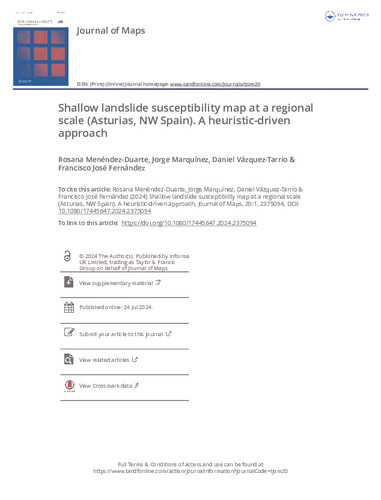Shallow landslide susceptibility map at a regional scale (Asturias, NW Spain). A heuristic-driven approach
Palabra(s) clave:
Rainfall-induced landslides; susceptibility map; heuristic models; geological/ geomorphological mapping
Fecha de publicación:
Editorial:
Taylor and Francis
Versión del editor:
Citación:
Resumen:
The study area (Asturias), located in NW Spain, is a mountainous region extending over 10,000 km2, where shallow landslides triggered after heavy rainfall episodes are very frequent and pose a major threat and hazard to infrastructure and human populations, causing significant economic losses and damage every year. In this regard, Shallow Landslide Susceptibility Mapping (SLSM) represents a very powerful tool for managers and agencies dealing with landslide hazards and land planning. Here we produced an SLSM for Asturias based on basic geological/geomorphological maps and a heuristic approach. The regional-scale model built here has a cell resolution of 50 m and combines bedrock geology, and surface deposits mapped at a1:25k scale together with a digital slope model. The resulting map was compared with two local inventories of landslides, giving a goodness of fit of 80 and 77.5%. To better understand the results, the erroneous data have been reviewed individually and the causes of error were analysed. Our study highlights the value of high-quality geological and, especially, geomorphological mapping for landslide susceptibility assessments .
The study area (Asturias), located in NW Spain, is a mountainous region extending over 10,000 km2, where shallow landslides triggered after heavy rainfall episodes are very frequent and pose a major threat and hazard to infrastructure and human populations, causing significant economic losses and damage every year. In this regard, Shallow Landslide Susceptibility Mapping (SLSM) represents a very powerful tool for managers and agencies dealing with landslide hazards and land planning. Here we produced an SLSM for Asturias based on basic geological/geomorphological maps and a heuristic approach. The regional-scale model built here has a cell resolution of 50 m and combines bedrock geology, and surface deposits mapped at a1:25k scale together with a digital slope model. The resulting map was compared with two local inventories of landslides, giving a goodness of fit of 80 and 77.5%. To better understand the results, the erroneous data have been reviewed individually and the causes of error were analysed. Our study highlights the value of high-quality geological and, especially, geomorphological mapping for landslide susceptibility assessments .
Patrocinado por:
Project CN-01-087-B3 ‘Mapping Hazards in the Principality of Asturias’ supported the General Direction of Planning and Urban Development (Principality of Asturias) and 2) Project CGL2007- 60230/BTE of the National Plan of Research of the Spanish Ministry of Education and Science. (3) Project PID2021-126357NB-100 funded by the Spanish Ministry of Science and Innovation
Colecciones
- Artículos [37544]
- Geología [551]
- Investigaciones y Documentos OpenAIRE [8416]
Ficheros en el ítem





